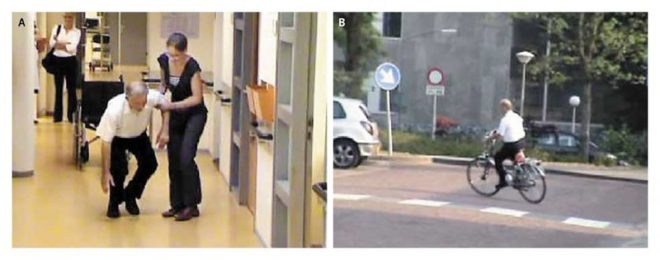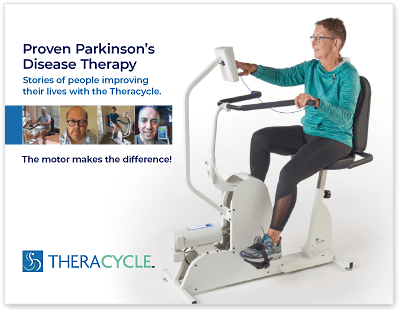Is financing available?
Yes. We offer interest-free financing up to 48 months through United Midwest Savings Bank. Applications are typically determined within 30 minutes of application submission.
Is Theracycle covered by insurance?
Theracycle is not covered by insurance, however 0% financing up to 48 months is available which makes the bikes very affordable. For additional details, please visit our Financing page, call one of our specialists at (855) 595-6596 or email us at financing@theracycle.com.
I have a movement disorder which precludes me from traditional type of exercise. Will the Theracycle really allow me to exercise?
Yes. The Theracycle’s motor assists you in attaining continuous exercise for longer periods that, due to lack of strength and endurance, would otherwise not be possible on traditional exercise equipment for users with movement disorders. We are so convinced the Theracycle will work for you, we offer a money-back guarantee within 30-days of delivery if you are not completely satisfied.
I have limited mobility. Will I be able to get on the Theracycle?
The Theracycle’s frame and recumbent seat was specially designed for easy mounting and dismounting for those with balance and mobility challenges. The open step-through base was engineered to allow you to easily get on and off the Theracycle safely and securely.
Is Theracycle safe to use?
The Theracycle is designed specifically for users with movement disorders and has many safety features. Its motion can be stopped instantly using either a push of a button or a pull of the safety cord. The structural steel frame can support up to 350lbs and cast iron parts are extremely durable and built to last. The seat is extra large for added comfort, safety and stability.
Is it difficult to operate the computer controls?
No, the user-friendly, easy-to-read control panel on the Theracycle lets you set your own time and speed. The display also tracks mileage and revolutions per minute information. Simple easy-to-follow instructions are provided.
Why does the Theracycle cost more than a basic exercise bike?
The Theracycle is not a simple or traditional exercise bike. The biggest difference is the unique motorized technology and the 15-speed variable gearbox, which allows you to attain and maintain a significantly faster cadence for a longer period than you can achieve using a traditional stationary or road bike. A Theracycle has been proven to reduce neurological symptoms and improve motor function and mobility.
Additionally, the bike is custom engineered for the specific needs of people with movement disorders, not only in its open walk-though design, but also when it comes to durability and, most importantly, stability. The Theracycle is built on a very sturdy, heavy structural steel frame. It has a low center of gravity by design, which is ideal for those with balance, dexterity or gait issues providing a safe and secure exercise option in the comfort of your own home. Also important is the motor-assisted handlebar which provides both core and upper body exercise with a repetitive rowing motion for a full-body workout. A Theracycle provides a meditative and relaxing option for both mental and physical therapy that is low impact to your joints and muscles.
Finally, there is the issue of quality. We want you to be able to use the Theracycle every day for years to come, so every component – mechanical and electrical – is built to provide decades of use without failure. All of our parts are precision-made, ensuring superior quality and durability. In addition to the powerful, highly specialized motor, the Theracycle is also equipped with sophisticated safety mechanisms and state-of-the-art electronics specifically designed for your needs. Every Theracycle is manufactured in the US and hand-built in Franklin, Massachusetts.
In the end, the cost difference is a function of several factors: durability, quality, safety, usability, and adaptability. That said, we are mindful that this is a real investment for our customers, and we don’t take it lightly. In fact, the Theracycle is considerably less expensive than other comparable motorized exercise/therapy products on the market, including the MOTOmed™ made in Germany, and the US made Flexiciser™, NuStep® (not motorized), and Restorative Therapies™.
Is there a suggested Theracycle workout that will improve my PD symptoms?
Studies show that riding at 14 to 15 miles per hours for 40 minutes, 3 times per week, can prompt a significant improvement in PD symptoms. It is recommended that you begin with an easy, 10-minute warmup and follow with a relaxing 10-minute cool down. Learn about the benefits of forced exercise with the Theracycle »
What are the Theracycle Specifications?
Theracycle 100
19″ W x 39″ L x 37″ H – 100 lbs. Boxed for shipping – 120 lbs
Theracycle 200 and 300
20″ W x 44″ L x 57″ H – 240 lbs. Boxed for shipping – 240 lbs
The electrical cord on all models is 9-feet long.








